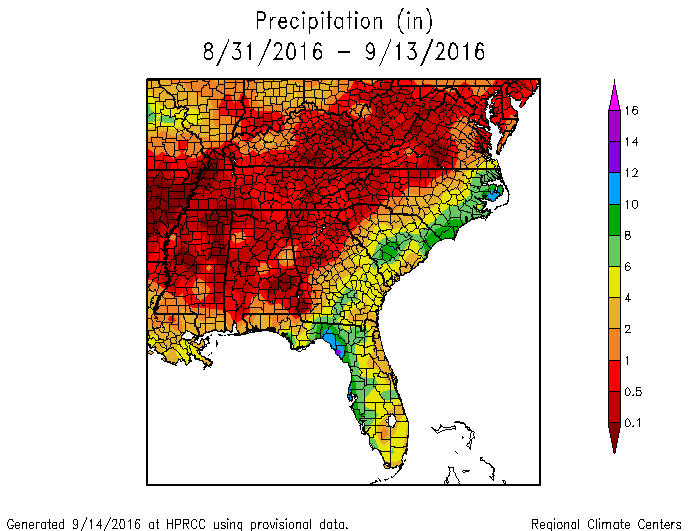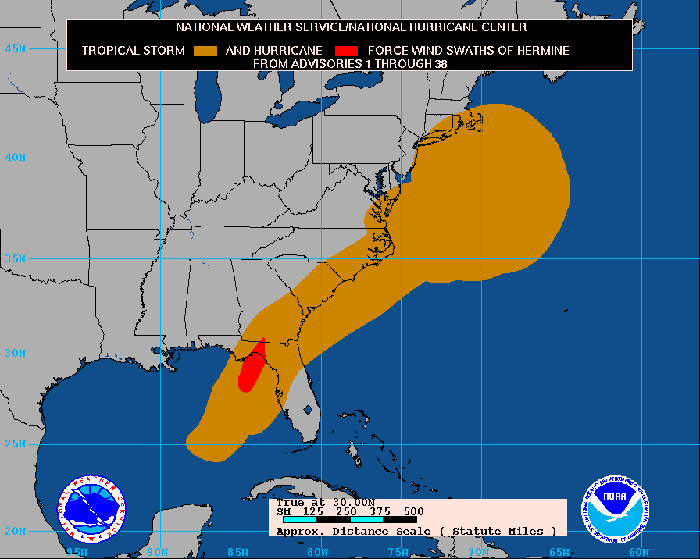Figure 1. Video of weather forecast for Friday September 2 showing movement through the Southeast of Hurricane Hermine. There is a brief advertisement at the beginning of the video.
Ian Small, Nicholas Dufault, Kelly O’Brien, and David Wright
Late season storms like hurricane Hermine (Fig. 1) and tropical depression Julia (and 12) often bring significant wind and rainfall to our region (Fig. 2). It is important to keep in mind the impacts this weather can have on your crops. While many row crops are already mature and in the process of being harvested, there might be some late planted crops, such as double crop soybeans and June-planted peanuts, that are susceptible to disease. So, what impact does the weather associated with Hermine and other tropical systems have on row crop growers? It means that the environment has become more conducive for disease, but more specifically, that:
- A combination of high moisture and wind speeds creates an environment optimal for fungal (e.g. soybean rust, Cercospora leaf blight, and frog eye leaf spot), oomycete (e.g. downy mildew), and bacterial pathogens (e.g. bacterial blight) to grow, infect, and spread.
- Weather systems like Hermine spread pathogens over short and long distances very effectively. Rain splash as well as wind-blown rainfall are efficient means for local dispersal of spores and bacteria in a field, but these factors are also critical to the release of spores into the atmosphere for long distance movement to fields miles away.
- Too much rain creates problems for growers by limiting access to fields for fungicide sprays and other management practices.
The role that hurricanes can play in spreading pathogens has been demonstrated by soybean rust, which was introduced into the continental US by hurricane Ivan in 2004. Since 2005, a network of soybean sentinel plots has been used to monitor the spread of soybean rust (www.sbrusa.net). In 2016, leading up to hurricane Hermine, several sentinel plots across Florida (14 out of 21 scouted counties by May 31) were found to be positive for soybean rust early in the season. By the end of August, 25 out of 27 scouted counties were positive, well ahead of previous years.
The large number of positive counties with soybean rust was likely due to the mild winter conditions that enabled the pathogen to overwinter more easily. The combination of above average (positive) soybean rust reports in Florida, and weather from Hurricane Hermine suggests that it is highly likely that the moisture and wind conditions were favorable for the spread of soybean rust spores along the path of Hermine (Fig. 4). With approaching cool autumn temperatures, the rust will spread even more, but by then, it will no longer be a threat to soybean production.
A question many of you are probably asking is, what can one do about the issues hurricanes and tropical weather systems cause? There is no simple answer to this question, but the first thing would be to assess your risk for disease. Your risk will depend on a number of factors including your crop growth stage, choice of cultivar, presence of pathogens on your farm (or in your region) and fungicide management program. Understanding your risk is an important step to deciding how to respond to environmental events like hurricane Hermine. It is important to scout your fields for disease at repeated intervals, because disease symptoms are only likely to show up 7 to 14 days after a weather event such as Hermine. The book A Farmer’s Guide to Soybean Diseases from the American Phytopathological Society provides some good information on how to identify and manage many soybean diseases.
Ultimately, each situation will be unique and nothing makes up for experience when dealing with diseases. Contact your local Extension Agents and consultants to find out what diseases are present in your region, as well as the management options that are available.
Links to online publications with more information on this topic:
Soybean Production in Florida
NC State IPM Soybean Disease Management
Fungicide Efficacy for Control of Foliar Soybean Diseases
- Disease Notes for the End of the 2023 Florida Peanut Season - November 3, 2023
- Identifying and Managing Corn Leaf Blights - May 19, 2023
- End of Season Peanut Disease Notes - September 30, 2022



